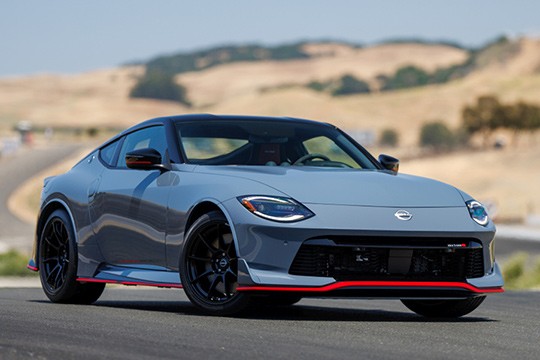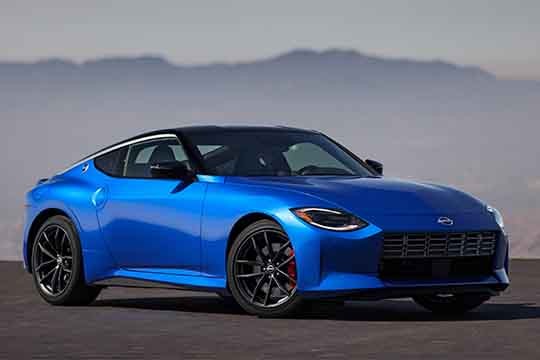NISSAN Z Models/Series Timeline, Specifications & Photos
First production year: 2021
Engines: Gasoline
Body style: Coupé (two-door)
Nissan didn’t wait too long before refreshing the seventh generation of the Z lineup and introduced the facelifted version of it in the Fall of 2023 for the 2024 model year.
Like its non-facelifted sibling, this Z was not made for the European market, so customers from the Old Continent were left with tears in their eyes. But those who could enjoy it knew that the 2024 Z was a better car than its non-facelifted version. The Japanese automaker improved it in every possible way, starting from the exterior and moving onto the interior and ending with the power department. For the last one, though, there were some mixed feelings.
The 2024 Z was available in three trim levels: Sport, Performance, and Nismo. There were some differences between these, with the first two featuring a shorter length since they didn’t have the same three-piece rear bumper nor the aggressive front splitter that was present on the top-spec version of the Z. In addition, the Sport was fitted with 18” forged alloy wheels, while the other two relied on 19” alloys, with unique Dunlop Sport MAXX tires for the Nismo. Furthermore, a bigger wing on the sportiest version confirmed the car’s track-oriented abilities. Also, there was a new set of taillights at the back of the 2024 Z featuring a new layout that made the car look wider. In addition, the Nismo had a red trim around the redesigned bumper and an ascending line towards the rear exhausts.
Inside, like its predecessor, the Z featured an 8-inch touch-sensitive display for the infotainment system and a digital display for the instrument cluster. But, as an option, Nissan offered an advanced infotainment unit fitted with a larger, 9-inch touchscreen. All versions were fitted with sports bucket seats, but only the Nismo had the opportunity to boast a set of Recaro ones. Regardless of the trim level, all of them featured a tall center console that housed a pair of cup holders and the gear stick or gear selector.
But the most significant upgrades happened under the car’s skin. There, Nissan added more braces under the front and rear axles and under the floor to make the car stiffer. As a result, it increased the Z’s rigidity by 2.5%. While that might not seem a lot, in reality, it transformed the vehicle. To compensate for the added stiffness and still be a comfortable vehicle on regular roads, the automaker re-tuned the dampers. Under the hood, all three versions were fitted with the same VR30DDTT 3.0L V6 twin-turbo engine as the 2022 Z, which generated 400 HP (406 PS) for the Sport and Performance and 420 HP (426 PS) for the Nismo variant. While the former two versions were available with a six-speed manual or a nine-speed automatic, the Nismo came exclusively with a two-pedal option, so no manual for the highest version of the 2024 Nissan Z.
Nissan unveiled a new generation of its Z-saga in August 2021 with a new model, which marked a return to the turbocharged engines like the older 300ZX from the '80s.
The history of Nissan's Z-cars started in 1969 with the Nissan Fairlady Z, marketed outside Japan as Datsun 240Z. It soon became a cult car thanks to its nimble handling and elegant, sporty lines. While in the beginning, it was a sporty coupe with not too many features, the seventh generation introduced in 2021 was a completely different story.
Its lines resembled those from the Z-Proto concept car unveiled in early 2021. Its long hood and short deck were already a design trademark for the Z-cars, and the Z400 followed it. A pair of LED headlights with half-circular DRL's resembled the older, round headlights of the first Fairlady. The new 3D LED taillights and the rear combination lamps combined modern technology into the aesthetics reminiscent of the Z32 300ZX.
Inside, the vintage-look design was enhanced by new technologies such as the 12.3" display in front of the driver complemented by the infotainment's touch-screen from the center stack. On top of the dashboard, a cluster with three analog dials showed data regarding the turbochargers and an ammeter.
But the most important part of the car was under the hood, where Nissan dropped a twin-turbocharged 3.0-liter V6 powerplant. Its 400 ponies were sent to the rear wheels via either a six-speed manual or a nine-speed automatic. A clutch-type limited-slip differential provides the much-needed grip for perfect launches.

